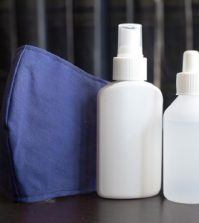- Study Says Most Parents Don’t Use Car Seats In Ride Share Vehicles Like Uber
- This 12-Year-Old Boy Is A Sophomore Aerospace Engineering Major!
- Fire Safety Experts Warn Of Hand Sanitizer Danger After A Mom and Kids Escape House Fire
- Recall Alert: Peaches May Be The Cause Of Salmonella Outbreak, 68 People Ill
- Summer Vacation In The Days Of COVID: Tips To Stay Safe
- How To Safely Grocery Shop During The Coronavirus Pandemic
- Michigan Teen With Vape-Related Illness Undergoes Double Lung Transplant
- Teen Kicks Off Anti-Vaping Campaign From Hospital Bed
- Teenager Receives Life Sentence For Strangling Sister To Death Over A Wi-Fi Password
- Toddler Falls To Death From 11th Deck of Cruise Ship
Teenager Attacked By Mysterious Sea Critters


A 16-year-old boy, Sam Kanizay, found his feet and ankles covered in blood after he soaked his legs in Melbourne’s Brighton Beach.
Jarrod Kanizay said that his son arrived home with what “looked like a war injury” and that his legs would not stop bleeding.
The family is now seeking expert opinion to identify the flesh-eating bugs.
Marine biologists say they were likely to have been sea fleas which are tiny scavenging marine animals.
After a football game on Saturday evening, the boy decided to soak his legs in the cold bay near his home. He described feeling pins and needles in his legs after standing waist-deep in dark cold water for about half an hour.
After shaking off what he thought was sand coated around his ankles, he walked on, not realizing that his feet were “covered in blood”.
“It bled for ages, and it’s still seeping blood now,” he said.”It looked like a war injury… like a grenade attack. It was really bloody,” his father told BBC News.
“We got him in the shower but as soon as we did that the blood kept re-appearing,” said Mr Kanizay.
“It wasn’t clotting at all. It just kept bleeding and bleeding.”
After two local hospitals couldn’t identify the cause of the multiple pin-prick injuries, the father decided to investigate and went back to the beach.”I collected these strange creatures from the same spot last night by trapping them in a net and standing in the water myself,” he said.
“We got thousands of these little mite-type bugs and they’ve been sent on to experts.”
Mr Kanizay said that he hoped the sandy-coloured mites would not scar his son, and that he is expected to make a full recovery.
“We are just waiting on the experts to tell us what they are and how they behave and why this happened.”
Marine biologist Dr Genefor Walker-Smith, who saw some of the samples, said that the bugs were probably lysianassid amphipods, or sea fleas.
“It’s possible he disturbed a feeding group but they are generally not out there waiting to attack like piranhas,” she said.
Such cases are very rare and that there is no reason for alarm, say experts.









0 comments